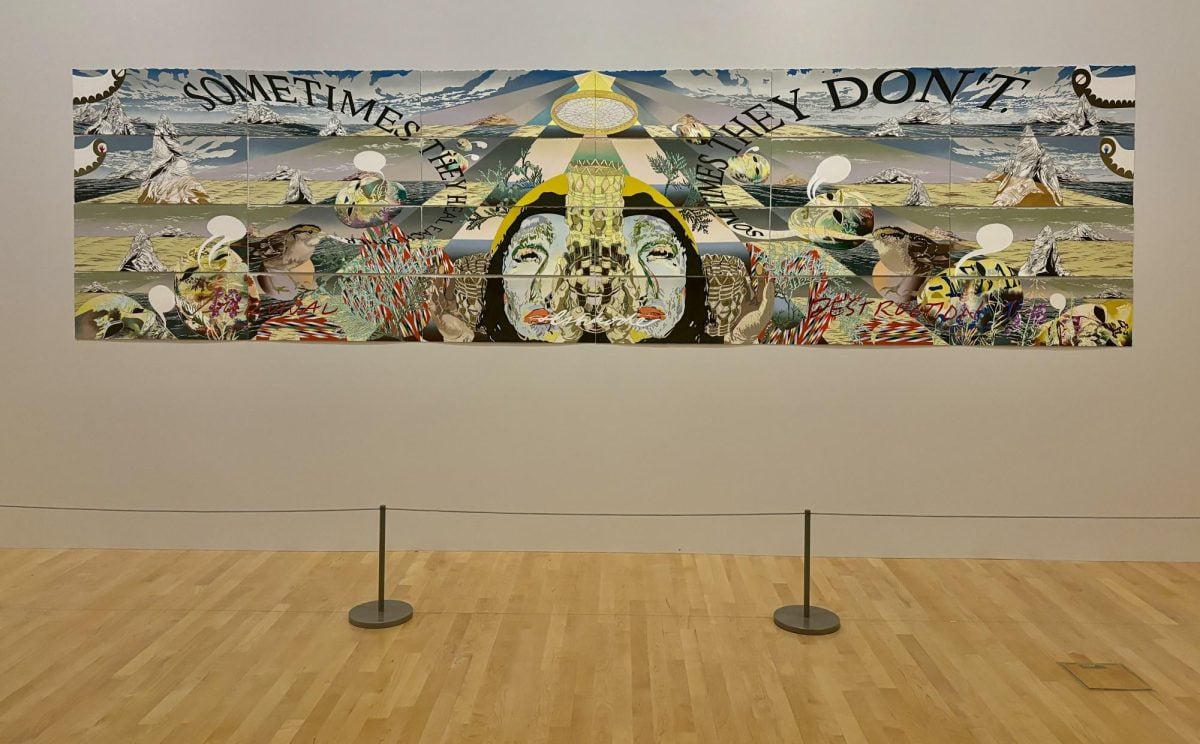
Andrea Carlson’s “The Indifference of Fire” explores the historical context of fire in relation to the Zhegagoynak region.
February 20, 2025
The Block Museum of Art’s latest exhibition, Woven Being: Art for Zhegagoynak/Chicagoland, explores the history of art in Chicagoland through Indigenous perspectives. The exhibition holds over 80 works by 33 Indigenous artists currently living in the city or from nations forcibly displaced from the area.
The city of Chicago has the third-largest urban Indigenous population in the U.S. The region is home to people from Indigenous nations including the Council of Three Fires — the Ojibwe, Potawatomi and Odawa — the Menominee, Miami, Ho-Chunk, Sac, Fox, Kickapoo and Illinois nations.
“It’s such an important exhibition for the region because Chicago has been a long-standing cultural and economic hub for Indigenous tribal nations,” Jordan Poorman Cocker, the show’s co-curator said. “Despite that rich and deep history that predates American history, Indigenous voices are often excluded from Chicago’s art histories, and that silence is harmful.”
The Block does not have full-time permanent Indigenous staff members. When thinking about how to craft the exhibition, it was important for them to have Indigenous voices involved, the Associate Director of Curatorial Affairs at Block Kathleen Berzock said.
Five years ago, Berzock and her former colleague, Janet Dees, reached out to the Terra Foundation, an organization that facilitates intercultural conversations to “expand narratives of American art.” Through one of the foundation’s programs, Art Design Chicago, The Block received funding for Woven Being and was able to hire Cocker, who is Kiowa, as well as two Indigenous Terra Foundation fellows, Marisa Cruz Branco and Teagan Harris, to work on the project.
The team also worked with four collaborative Indigenous artists — Kelly Church, Nora Moore Lloyd, Jason Wesaw and Andrea Carlson — to design the show. They met about once a month, coming up with artists and works to include, as well as, ideas for their own creations, Wesaw said.
“I think in Woven Being, just in the title alone, you can understand that there are many different threads or many different ideas that are woven into this one exhibition,” Wesaw said. “We made sure that it was about our communities, our friends, our fellow artists.”
Cruz Branco said the exhibition centers around the land. Some pieces focus on material kinship, honoring different materials like birch bark, black ash, sweetgrass and cedar. Others focus on the land’s close relationship to waterways.
Woven Being works to weave together the past, present and future of Indigenous communities. From historical works by deceased artists to contemporary works, the show is about celebrating the relationships between the artists and communities across time periods, Poorman Cocker said.
For Moore Lloyd, this aspect of the show is particularly important.
For the first half of Moore Lloyd’s life, she did not know she was native. Her grandmother, who was born on the Lac Courte Oreilles reservation, was forced to attend a mission school and then was kidnapped by missionaries and moved from Wisconsin to Indiana.
She died without telling her children that she was native. After her family found old letters, Moore Lloyd went to Lac Courte Oreilles to see where she was from, she said.
Moore Lloyd said the elders took her in and the oldest elder in the tribe mentored her as she learned about her history. Because of this, Moore Lloyd was passionate about bringing the works of elders to the show, inviting artists who created art in the 1980s.
“I snuck in before the opening, and it just took my breath away,” Lloyd said. I wasn’t sure how all these pretty different works would come together as a story, but they do. It just reinforced how important the community is and how important it is for all these viewpoints to be highlighted.”
The exhibition also has a community room, a space that invites reflection apart from the artwork. It was important to make a room for Indigenous people to be able to relax, laugh, discuss and reflect on the show in a less formal way, Cruz Branco said.
Woven Being opened on Jan. 25 and will run until July 13.
“It’s really just a way to assert our presence, our voices (and) our ideas as modern, native people in American culture,” Wesaw said. “Through our arts, I think we’re able to show not only the beauty and the reverence that we have for continuing our tribal lifeways, but also to begin to go deeper than just the surface of these conversations where people are longing to feel loved and accepted and welcome.”
Email: [email protected]
X: @ClareKirwan31
Related Stories:
— Block Museum hosts webinar on artwork connected to One Book One Northwestern
—Dittmar Gallery hosts community show ‘Metamorphosis,’ explores themes of evolution and transformation
— Evanston Art Center’s “The Four Virtues: Wonder” explores Afro-American diaspora, experience of Black men and boys
- Block Museum of Art
- Terra Foundation
